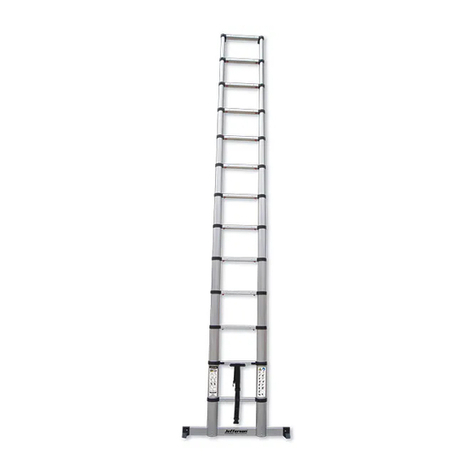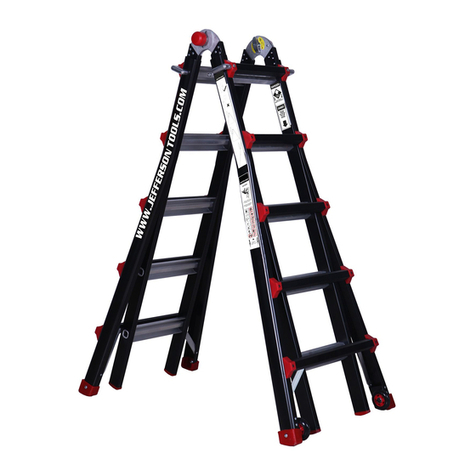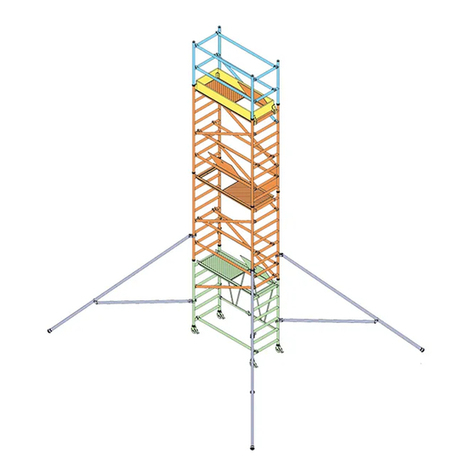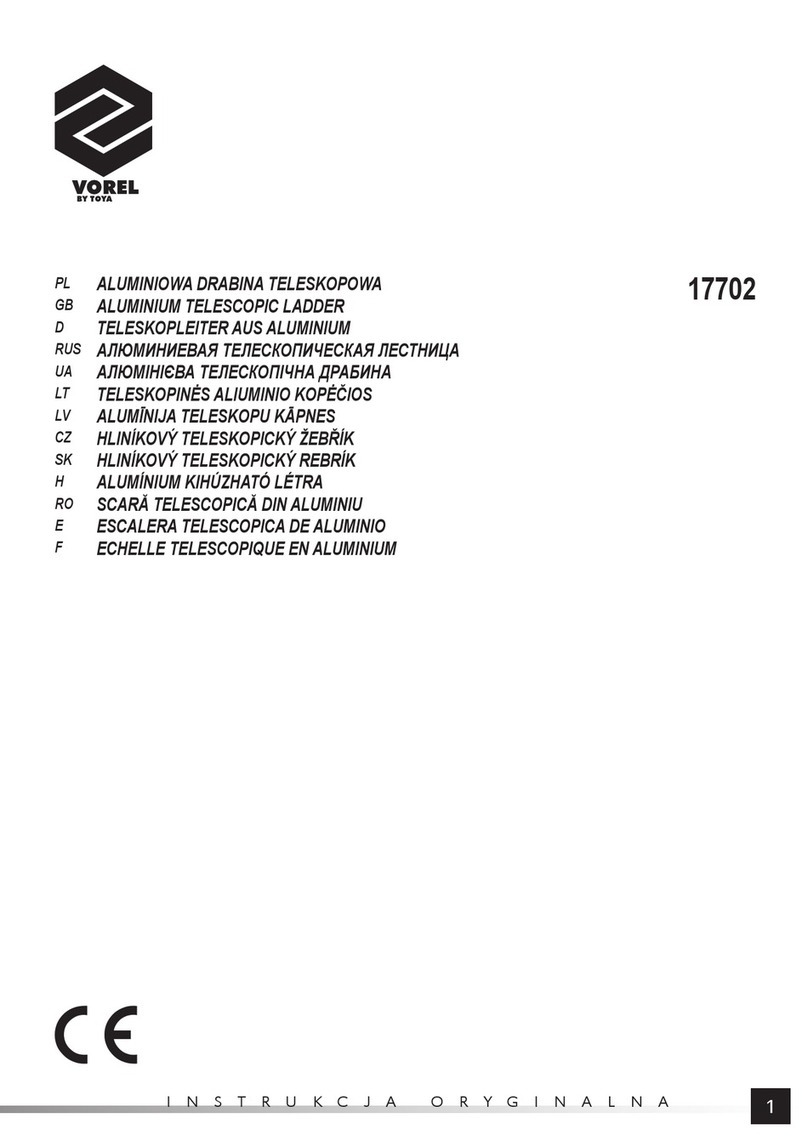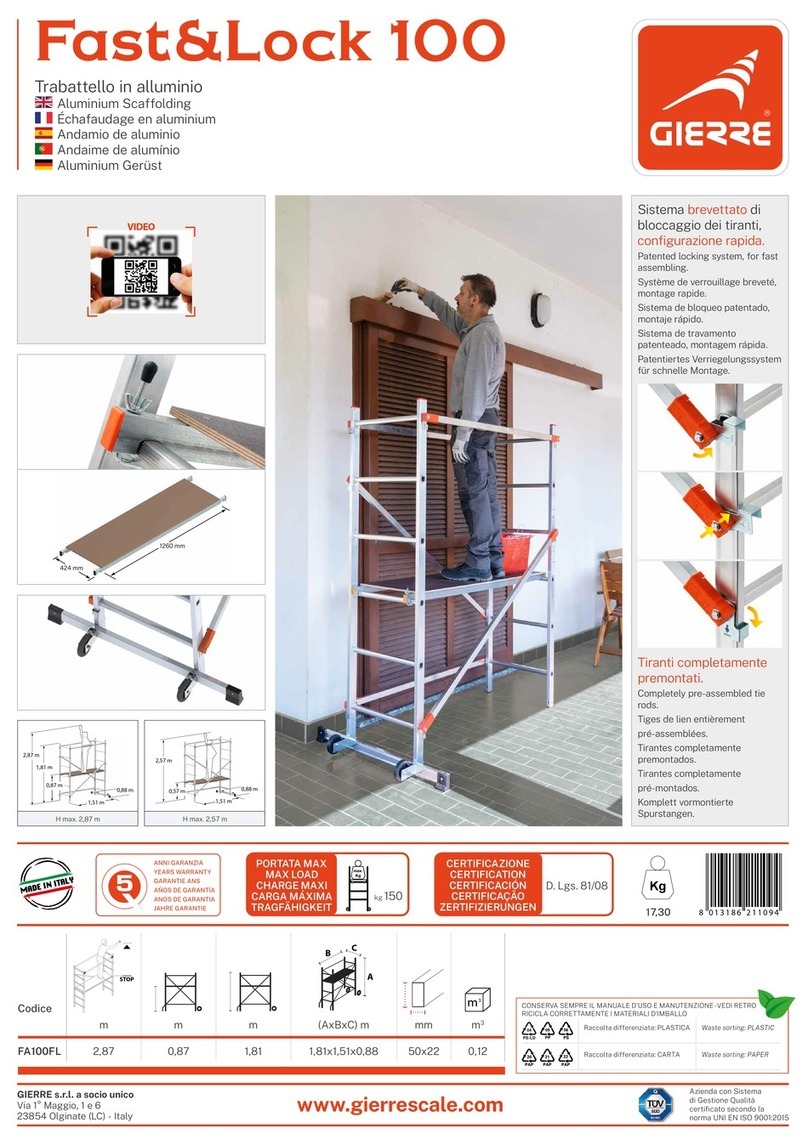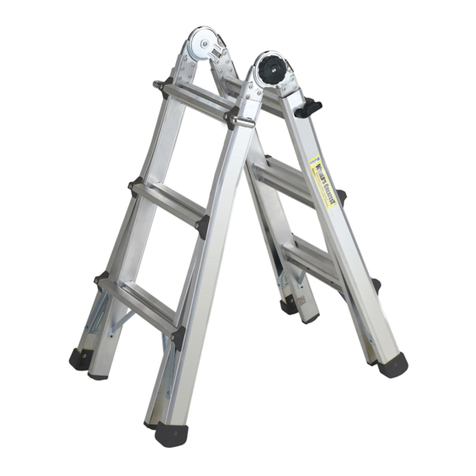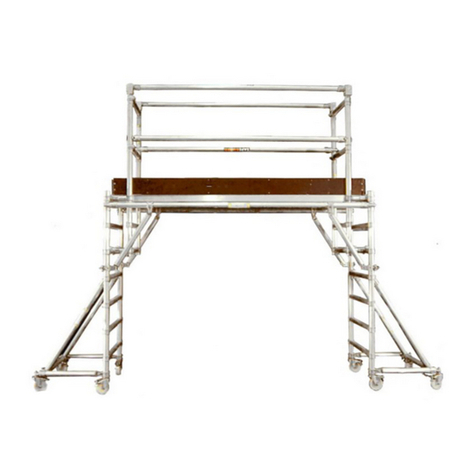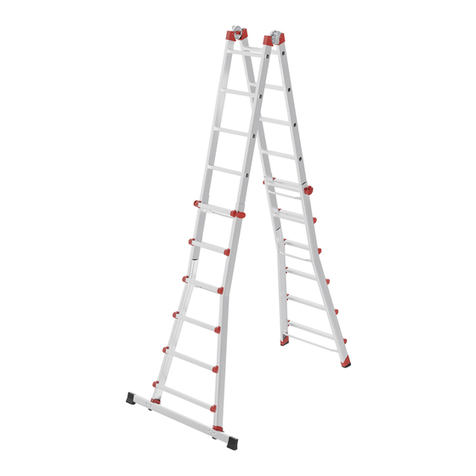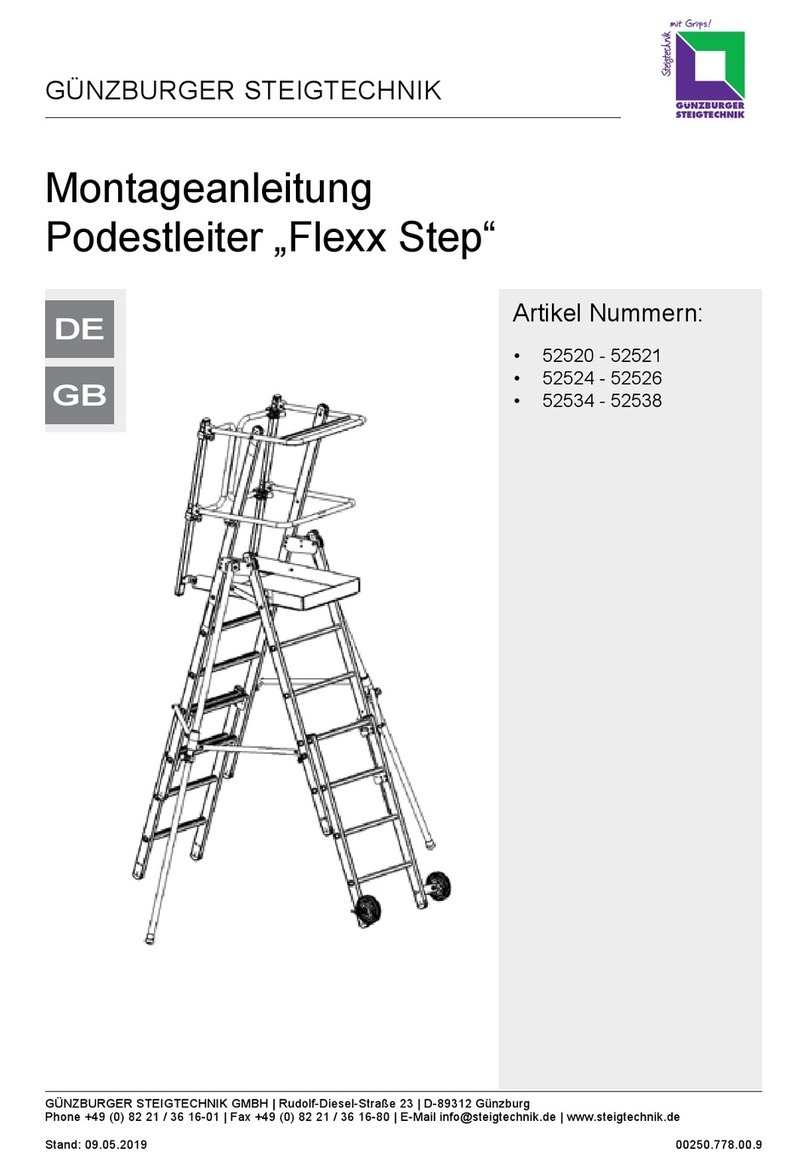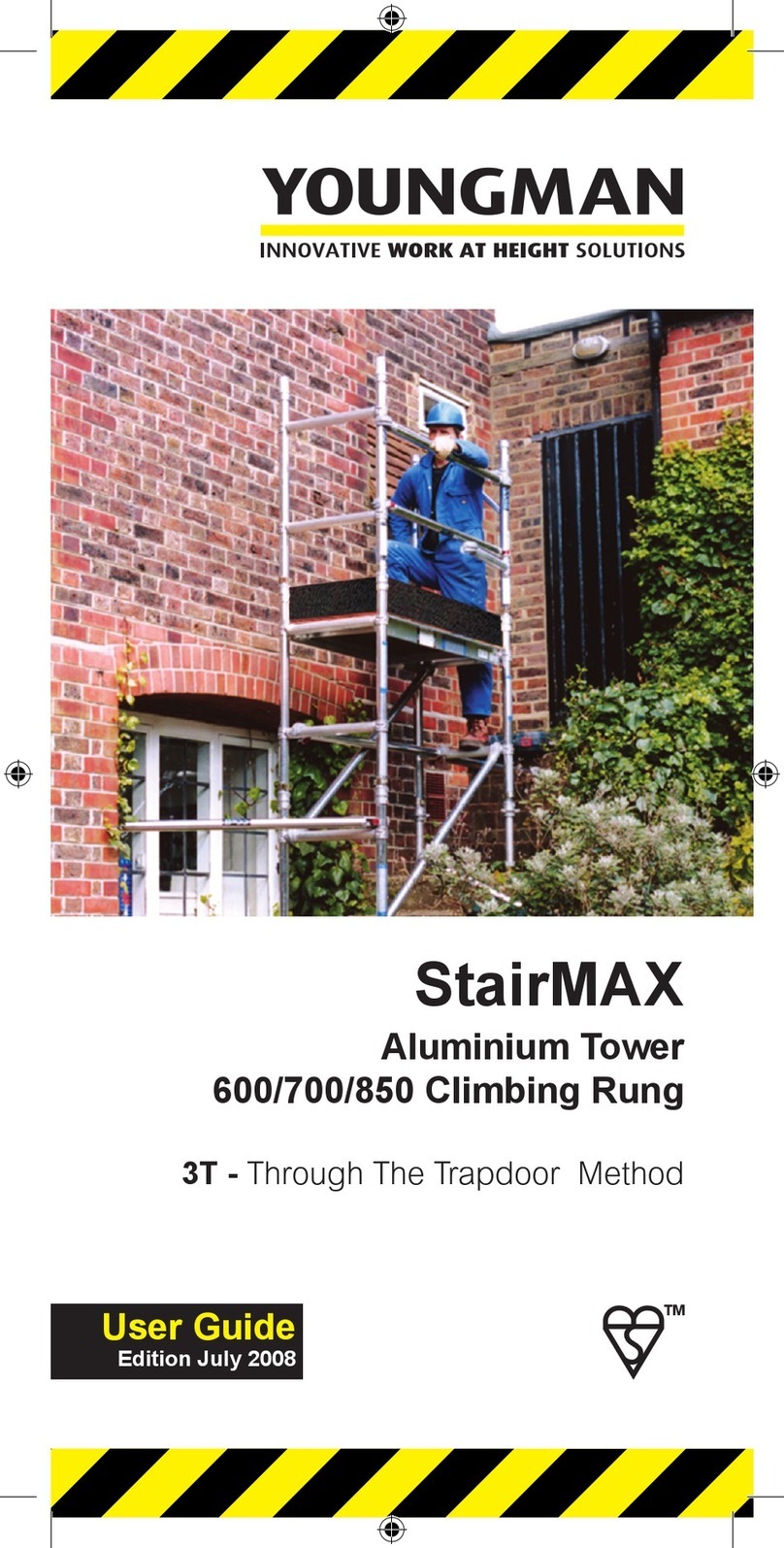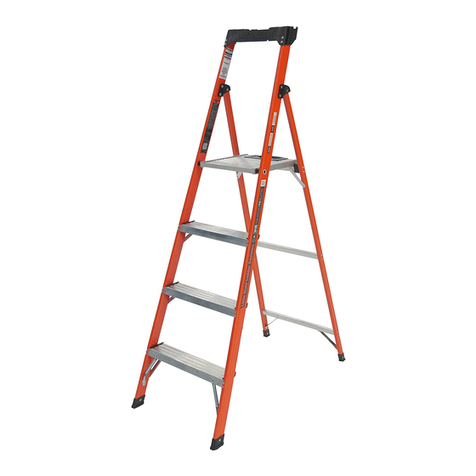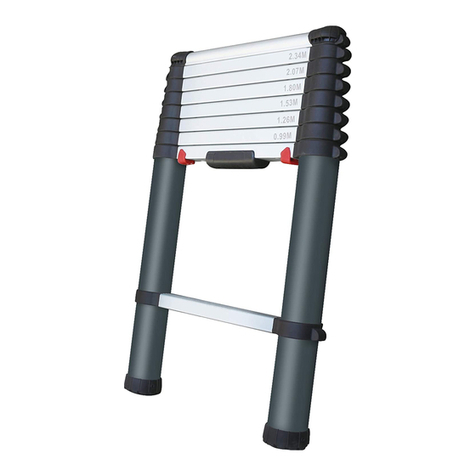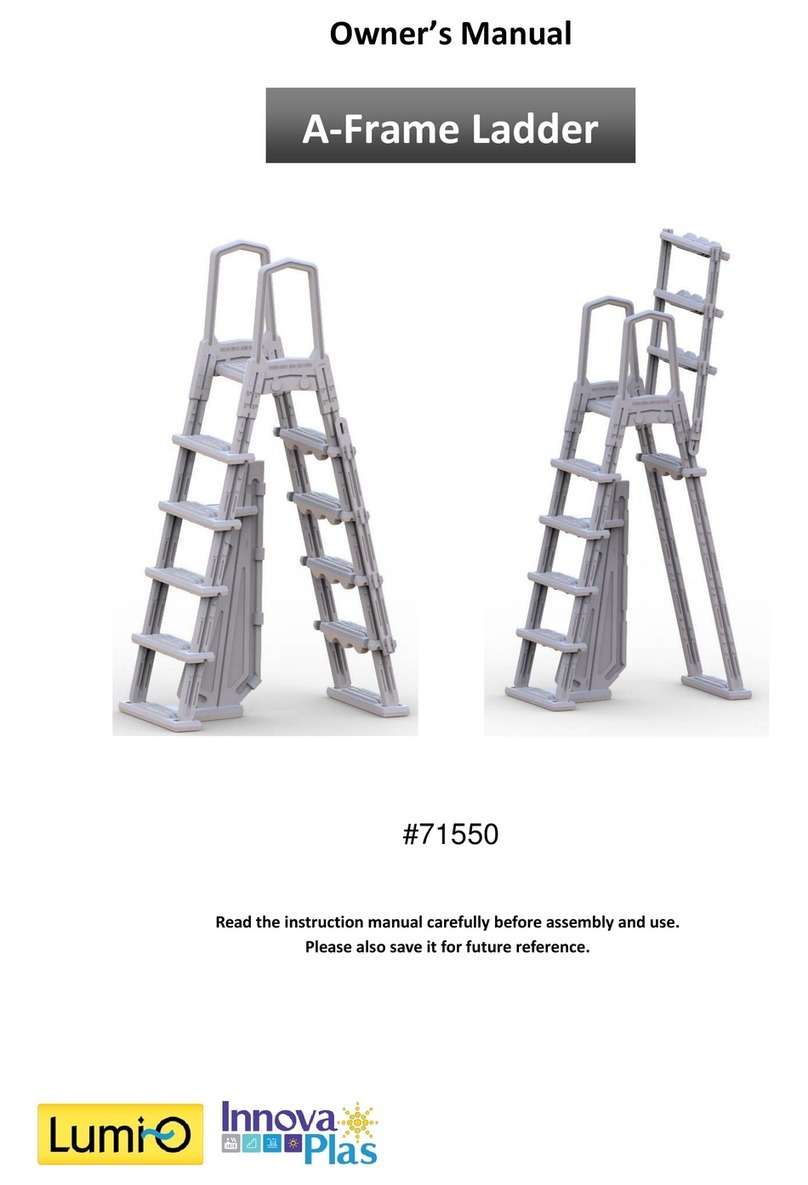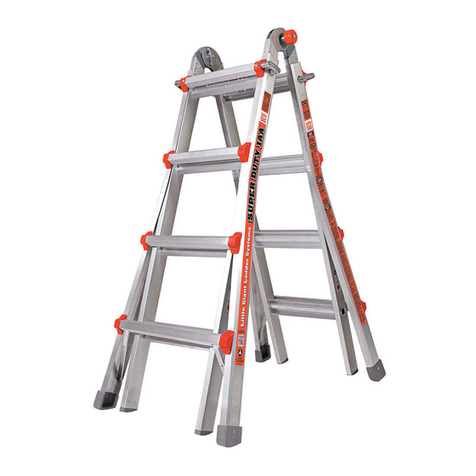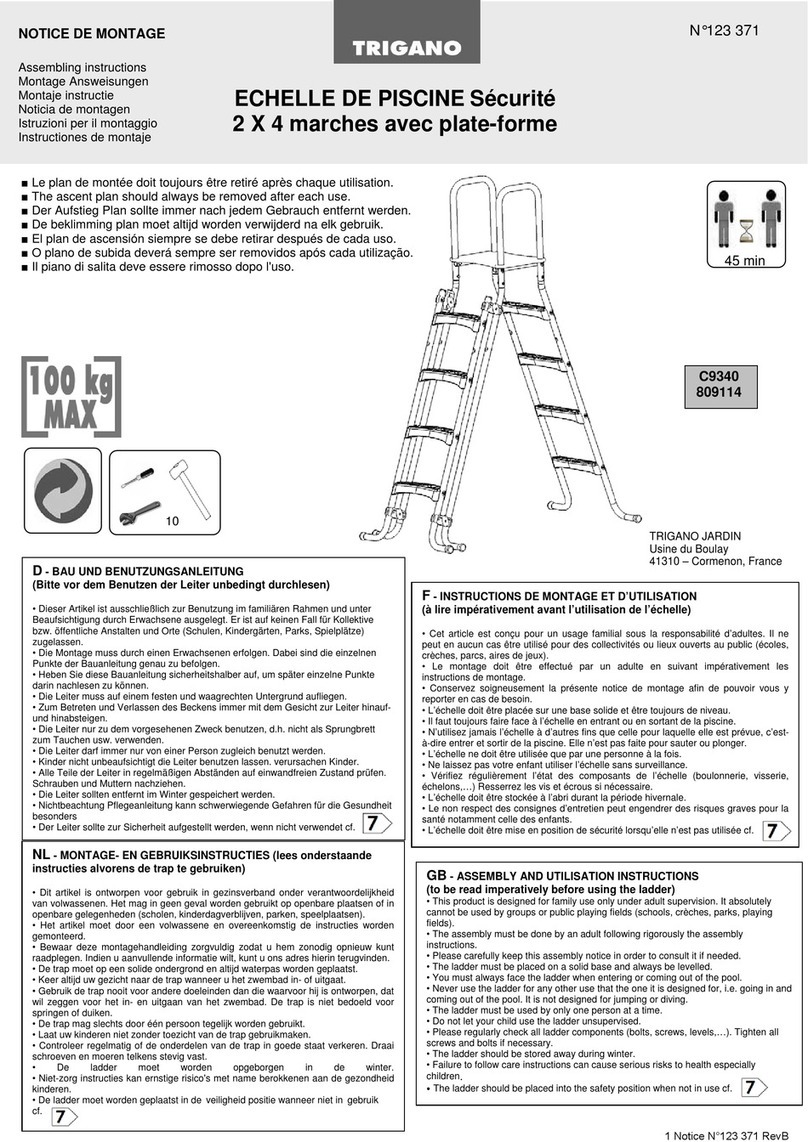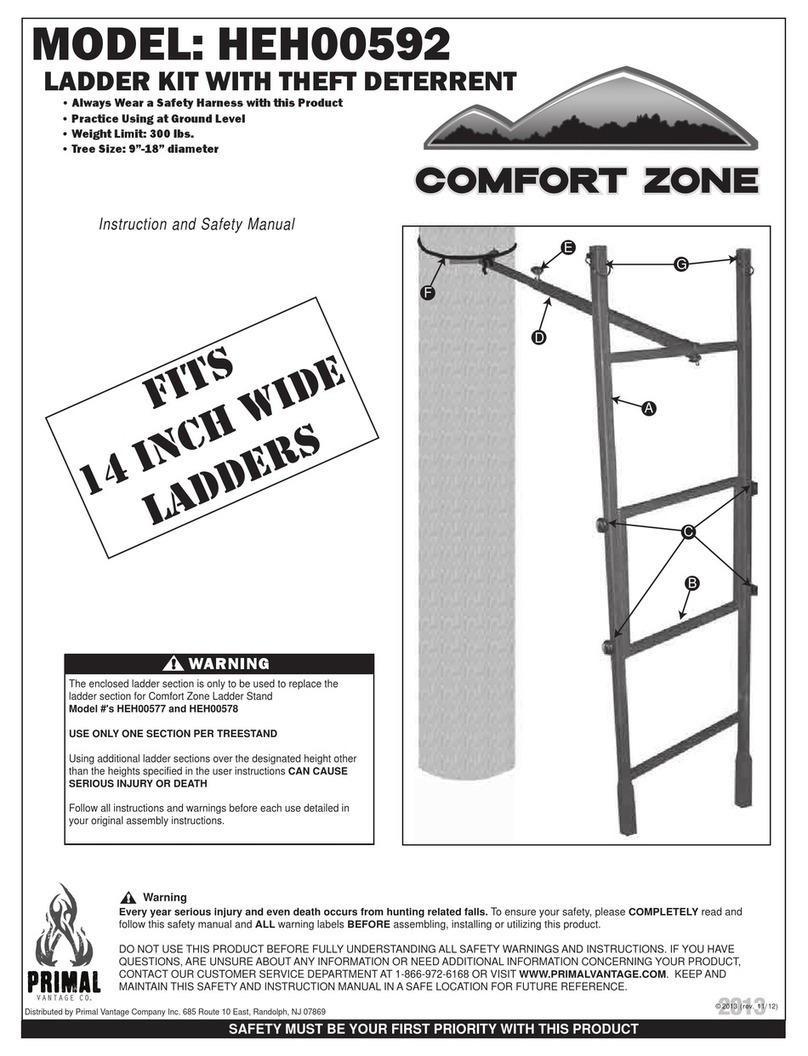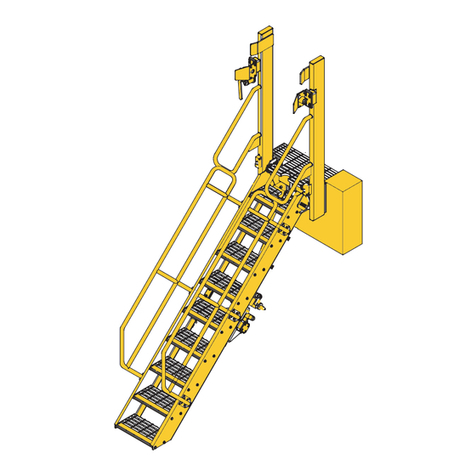Jefferson JEFLADTEL10 User manual

www.jeffersontools.com
FEATURES
User Manual
v.1.1
JEFLADTEL10
WARNING! Failure to adhere to the warnings and
instructions contained in this manual and on the
product could result in serious or fatal injury.
SPECIFICATIONS
Closed height: 80.5 cm
Opened height: 2.9 m
Safe working height: 1.7 m
Width: 47.6 cm
Maximum Load: 150 kg
Weight: 9.5 kg
MAX
150KG
• Strong, lightweight and portable aluminium alloy frame & safe closing system
• Compact telescopic frame design for storing in conned spaces
• Equipped with a locking mechanism for enhanced safety and peace of mind
while working
• Wide-base top bar and bottom rung provides added stability and sturdiness
• 10 x large slip resistant treads
• Hand grips for extra security and stability while climbing
• Anti-slip feet for added grip and durability.
• Supplied with secure fastening storage strap
• Manufactured and tested to EN 131-6: 2019
TELESCOPIC
LADDER
10 Rungs • EN 131-6: 2019

www.jeffersontools.com
User Manual
v.1.1
JEFLADTEL10
1. SAFETY
WARNING:
PLEASE READ THESE INSTRUCTIONS CAREFULLY
AND KEEP FOR FUTURE REFERENCE
1.1. Identify any electrical risks in the work area, such as overhead lines or other exposed electrical equipment.
1.2. This ladder does not offer insulation or protection from electrical hazards.
1.3. The ladder shall be only be positioned at on its feet, not the rungs or steps.
1.4. Never position or use the ladder on slippery surfaces (such as ice, shiny surfaces or signicantly contaminated solid surfaces)
unless additional effective measures are taken to prevent the ladder slipping or ensuring contaminated surfaces are sufciently clean.
1.5. The ladder shall be erected at the correct position, such as the correct angle for a leaning ladder (angle of inclination approximately 1:4)
with the rungs or treads level (e.g. 1m away from the base of a wall if extending to climb 4m up (see fig.A)).
1.6. Always position the ladder against a at, non-fragile surface and secure properly before use e.g. tied down or with the
use of a suitable stability device.
1.7. The locking mechanisms for all the extended rung sections shall be locked before using the ladder.
1.8. Never attempt to move or reposition the ladder from above.
1.9. The Jefferson 2.9M Telescopic Ladder is constructed from a lightweight aluminium alloy for a strong and portable
climbing solution for domestic use.
1.10. Extends and locks rung by rung to reach the perfect level with secure locking tabs for smooth and responsive adjustment.
BEFORE USE
1.11. Before using the ladder it shall be checked that all locking mechanisms are working properly.
If the mechanism is not working properly, do not use the ladder.
1.12. Wear tight-tting clothing, remove jewellery and tie long hair back when using the ladder.
1.13. Always wear suitable footwear when climbing a ladder; at, dry, treaded, shoes with securely tied laces are
considered appropriate footwear.
1.14. Ensure that the surface you will rest the ladder against is capable of supporting the combined weight of the ladder,
operator and any carried objects.
1.15. Doors (but not re doors or similar), windows and areas of entry/exit should be secured when using the ladder.
1.16. All distractions should be reasonably avoided. Always set up the Telescopic Ladder so that it is always freely accessible.
1.17. When transporting ladders on roof bars or in a truck, ensure they are suitably placed and secured to prevent damage.
1.18. The ladder shall be inspected after delivery and before every use to conrm condition and operation of all parts.
Use the checklist provided in the ‘Before Use: Risk Assessment’ section of this manual.
1.19. Visually check that the ladder is not damaged and is safe to use at the start of each working day when the ladder is to be used.
1.20. Remove any contamination from the ladder, such as wet paint, mud, oil or snow.
1.21. For professional users, regular periodic inspection is required.
1.22. Before using a ladder at work, a risk assessment should be carried out respecting the legislation in the country of use.
1.23. Ensure the ladder is suitable for the task. If unsure, contact a qualied person for guidance.
1.24. Do not use a damaged or otherwise unsuitable ladder.
USING THE LADDER
1.25. Do not exceed the maximum total load of 150kg/330lbs for this ladder.
1.26. Only allow one person to use the ladder at any time.
1.27. Ladders should only be used for light work of short duration.
1.28. Use non-conductive ladders for unavoidable live electrical work. This ladder is not suitable for live electrical work as it is
conductive and offers no protection from electrical hazards.
1.29. Never erect or use the ladder upside down. The base should always sit rmly on the ground.
1.30. Do not use the ladder outside in adverse weather conditions, such as strong wind or rain.
1.31. Do not leave an extended ladder unattended.
1.32. Take precautions against children playing on the ladder.
1.33. Do not place any tools or other objects on the rungs and do not hang anything on the ladder system.
1.34. Equipment carried while using a ladder should be light and easy to handle.
1.35. Face the ladder and keep a secure grip when ascending and descending.
1.36. Do not slide down the stiles of the ladder.
1.37. Climb and descend with deliberate movements.
1.38. Always maintain 3 points of contact with the ladder at all times e.g. two feet on the same rung and a hand on the stiles.
1.39. Use additional safety equipment if this is not possible.
1.40. Maintain a handhold whilst working from a ladder or take additional safety precautions if you cannot.
1.41. Do not overreach; always keep your belt buckle (navel) inside the stiles and both feet on the same step/rung throughout the task.
1.42. Avoid work that imposes a sideways load on ladders, such as side-on drilling through solid materials (e.g. brick or concrete).
1.43. In the leaning ladder position it is not allowed to climb higher than last metre of the ladder.
1.44. The user shall put the hands around the stile when bringing the ladder from extendedto storage position.
1.45. Do not stand on the top three rungs on the ladder; this can cause stability issues.
1.46. Do not use the ladder as a bridge.
1.47. Leaning ladders used for access to a higher level should be extended at least 1m above the landing point
1.48. Do not step off a leaning ladder at a higher level without additional security, such as tying off or use of a suitable stability device.
1.49. Do not step off the side of the ladder.
1m
4m
(Fig.A)

www.jeffersontools.com
User Manual
v.1.1
JEFLADTEL10
1. SAFETY
POSITIONING AND ERECTING THE LADDER
1.50. Do not spend long periods on a ladder without regular breaks (tiredness is a risk).
1.51. Take care when closing the ladder to not catch any ngers, clothing or hair in the mechanisms. Close one rung at a time.
1.52 Ensure the ladder is fully collapsed, all locks are secured and the ladder is free from contaminants before moving to the area of work.
1.53 Only erect and close in a safe work area.
1.54. Do not move the ladder when erect.
1.55. Only position and use the ladder on an even, level and unmoveable base.
1.56. When positioning the ladder, take into account risk of collision with the ladder e.g. from pedestrians, vehicles or doors.
1.57. Secure doors (not re exits) and windows where possible in the area.
1.58. Ensure that you are t enough to use a ladder. Certain medical conditions or medication, alcohol or drug abuse could make ladder use
unsafe.
2. REPAIR, MAINTENANCE AND STORAGE
REPAIR, MAINTENANCE AND STORAGE
2.1. Fully collapse the ladder, closing all rungs, and secure before storage or handling.
2.2. Clean with a suitable proprietary household cleaner and a soft dry cloth.
2.3. Dry all parts thoroughly before storing.
2.4. Do not submerge your ladder in water or any liquid for any reason.
2.5. Store your ladder indoors in a dry environment away from other contaminants. Do not rest other objects on the ladder.
2.6. Only store the ladder whenit is dry.
2.7. Do not subject your ladder system to humid or damp environments. These can damage the ladder.
2.8. Store the correct way up. The base should always sit on the ground.
2.9. Repairs and maintenance shall be carried out by a competent person with suitable replacement parts. Unapproved third party spares
are not recommended and will void your warranty.
2.10. For the angle indicator on the ladder, straight up parallel to wall and level parallel to ground.
2.11. To get the most out of your Telescopic Ladder, and for safety purposes, always clean the Ladder before and after use.
2.12. The Telescopic Tubes (5) must be kept clean; dirt, lings, paint, glue etc. must be cleaned away using a clean cloth after use
and before the Ladder is closed. Take care to also clean the rungs.
TIP:
For tougher stains, a small amount of non-abrasive cleaner can be added to a soft tissue or cloth. After cleaning, the Telescopic Tubes must be
treated with a silicon spray by opening all sections of the Ladder, spraying and wiping them clean with a paper towel or dry cloth. The Ladder must
always be dry. The end caps of the Ladder must always be sealed to prevent the ingress of dirt and other objects into the body which may cause
the Telescopic Tubes to become damaged. Any damage to your Telescopic Ladder should be repaired by a qualied person only.
WARNING!
Do not use your Ladder if damaged as this poses a severe risk of accident or injury and will void your warranty.
BEFORE USING THE 2.9M TELESCOPIC LADDER, PLEASE EXAMINE OUR ASSESSMENT FORM:
INSPECTION POINT YES NO
RUNGS: Are any rungs loose, cracked, bent, worn or missing?
RAILS: Are any rails loose, cracked, bent, split, frayed or worn?
LABELS: Are any labels missing or unreadable?
RUNG LOCKS: Are any rung locks loose, stuck, missing or broken?
HARDWARE: Is any hardware (screws/bolts/xings) missing,
loose or broken?
SHOES: Are the shoes worn, broken, unstable, loose or missing?
ADDITIONAL POINTS
CLEANLINESS: Is the ladder free from dirt/water/oil or other contaminants
which may impair safety or function?
Clean and dry the ladder before use.
SECURE AREA: Have all doors (excluding re doors or exits), windows and
distractions been secured and taken care of to prevent accident?
Secure all points before use.
FIT FOR PURPOSE: Are you condent that the ladder and any tools are t
for purpose and suitable for the task at hand?
Seek alternatives suitable for the task.
ADDITIONAL MEASURES: Have any additional safety measures necessary
for the task been taken? (i.e. securing of the ladder, well lit environment,
safety risk assessment been made?)
Do not proceed until all appropriate measures
have been taken.

www.jeffersontools.com
User Manual
v.1.1
JEFLADTEL10
3. TROUBLESHOOTING
PROBLEM SOLUTION
LOCKING MECHANISMS WILL NOT ENGAGE The rungs are not properly positioned. Extend to the maximum height
for the rung and attempt to secure again.
TELESCOPIC TUBES ARE STIFF The Ladder is dirty/contaminated and must be cleaned as instructed in
the ‘Care & Maintenance’ section above.
4. EQUIPMENT IDENTIFICATION
Top Bar
Storage Strap
Hand Grips
Locking
Mechanism
Telescopic Tubes
Bottom Rung

www.jeffersontools.com
User Manual
v.1.1
JEFLADTEL10
6. OPERATION
CLOSED INTERMEDIATE LENGTH FULL LENGTH
OPERATION
The Telescopic Ladder can be used at various heights for different tasks. Closed Intermediate length Full length
NOTE:
The Telescopic Ladder should be inclined using the 1-4 rule; for every 4 parts up, the Ladder should be placed 1 part out (e.g. 2m up, 50cm out).
The Telescopic Ladder can be used at various heights for different tasks.
5. LOCKING MECHANISM
The Locking Mechanisms (3) lock each rung with 2 steel locking pins that automatically spring into place when the Ladder is extended.
CAUTION:
Ensure all Locking Mechanisms are engaged before and after use.
To collapse the Telescopic Ladder down to its closed position, push the Locking Mechanisms (3) together simultaneously (FIG 1) and release.
Fig.1 Fig.2

www.jeffersontools.com
User Manual
v.1.1
JEFLADTEL10
Place the Telescopic Ladder on a
rm, level surface. Place your foot
on the Bottom Rung (6) to stabilise
the Ladder.
Starting with the second rung from
the bottom, use both hands to
grasp the Hand Grips (4) on either
side of the rung and pull upwards
to extend the step.
7. OPEN THE LADDER TO INTERMEDIATE LENGTH
8. OPEN THE LADDER TO FULL LENGTH
To close the ladder
When each step is fully extended, you should
hear a “click”, conrming that the Locking
Mechanisms (3) are engaged for that level.
Lock indicator lever displays when
each rung has successfully locked.
Hold the Telescopic Ladder in an upright
position. Place one foot on the Bottom Rung
(6) to stabilise the Ladder. Starting at the
lowest extended rung, use both hands to
grasp the Hand Grips (4) on either side of the
rung, then, with your thumbs, disengage the
Locking Mechanisms (3).
Fig A. Fig B. Fig C.
Bottom
Rung
2.
1.
C
l
i
c
k
C
l
i
c
k
Place the Telescopic Ladder on a rm, level
surface. Place your foot on the Bottom Rung
(6) to stabilise the Ladder.
Starting with the Top Bar (1), use both hands
to grasp the Hand Grips (4) on either side of
the rung and pull upwards to extend the step.
When each step is fully extended, you should
hear a “click”, conrming that the Locking
Mechanisms (3) are engaged for that level.
Fig A. Fig B. Fig C.
Top
Bar
C
l
i
c
k
Note: It is correct that the ladder will NOT lock until fully extended. As soon as upward pressure is released on the step it will self-retract.
This is normal and is a requirement of the EN131:6 standard, it is NOT a fault with the ladder.
C
l
i
c
k

User Manual
v.1.1
JEFLADTEL10
Jefferson Professional Tools & Equipment, or hereafter “Jefferson” warrants its customers that
its products will be free of defects in workmanship or material. Jefferson shall, upon suitable
notication, correct any defects, by repair or replacement, of any parts or components of
this product that are determined by Jefferson to be faulty or defective. This warranty is void
if the equipment has been subjected to improper installation, storage, alteration, abnormal
operations, improper care, service or repair.
Warranty Period
Jefferson will assume both the parts and labour expense of correcting defects during the
stated warranty periods below.
All warranty periods start from the date of purchase from an authorised Jefferson dealer. If
proof of purchase is unavailable from the end user, then the date of purchase will be deemed
to be 3 months after the initial sale to the distributor.
1 Year
• Jefferson 2.9M Safe Close Telescopic Ladder [JEFLADTEL10].
90 Days
• All replacement parts purchased outside of the warranty period
Important: All parts used in the repair or replacement of warranty covered equipment will be
subject to a minimum of 90 days cover or the remaining duration of the warranty period from
the original date of purchase.
Warranty Registration / Activation
You can register and activate your warranty by visiting the Jefferson Tools website using the
following address: www.jeffersontools.com/warranty and completing the online form.
Online warranty registration is recommended as it eliminates the need to provide proof of
purchase should a warranty claim be necessary.
Warranty Repair
Should Jefferson confirm the existence of any defect covered by this warranty the defect will
be corrected by repair or replacement at an authorized Jefferson dealer or repair centre.
Packaging & Freight Costs
The customer is responsible for the packaging of the equipment and making it ready for
collection. Jefferson will arrange collection and transportation of any equipment returned under
warranty. Upon inspection of the equipment, if no defect can be found or the equipment is not
covered under the terms of the Jefferson warranty, the customer will be liable for any labour
and return transportation costs incurred. These costs will be agreed with the customer before
the machine is returned.
NOTE: * Jefferson reserve the right to void any warranty for damages identified as being
caused through misuse *
Warranty Limitations
Jefferson will not accept responsibility or liability for repairs made by unauthorised technicians
or engineers. Jefferson’s liability under this warranty will not exceed the cost of correcting the
defect of the Jefferson products.
Jefferson will not be liable for incidental or consequential damages (such as loss of business
or hire of substitute equipment etc.) caused by the defect or the time involved to correct the
defect. This written warranty is the only express warranty provided by Jefferson with respect to
its products.
Any warranties of merchantability are limited to the duration of this limited warranty for the
equipment involved.
Claiming Warranty Coverage
The end user must contact Jefferson Professional Tools & Equipment:
(Tel: +44 (0) 1244 646 048) or their nearest authorised Jefferson dealer where final
determination of the warranty coverage can be ascertained.
Step 1 - Reporting the Defect
Online Method:
Visit our website www.jeffersontools.com/warranty and complete the Warranty Returns form.
You can complete the form online and submit it to us directly or download the form to print out
and return by post.
Telephone Method:
Contact your Jefferson dealer or sales representative with the following information:
• Model number
• Serial number (usually located on the specification plate)
• Date of purchase
A Warranty Returns form will be sent to you for completion and return by post or fax, together
with details of your nearest authorised Jefferson repair centre. On receipt of this form Jefferson
will arrange to collect the equipment from you at the earliest convenience.
Step 2 - Returning the Equipment
It is the customer’s responsibility to ensure that the equipment is appropriately and securely
packaged for collection, together with a copy of the original proof of purchase. Please note
that Jefferson cannot assume any responsibility for any damage incurred to equipment during
transit. Any claims against a third party courier will be dealt with under the terms & conditions
of their road haulage association directives.
NOTE: Jefferson will be unable to collect or process any warranty requests without a copy of
the original proof of purchase.
Step 3 - Assessment and Repair
On receipt, the equipment will be assessed by an authorised Jefferson engineer and it will
be determined if the equipment is defective and in need of repair and any repairs needed are
covered by the warranty policy. In order to qualify for warranty cover all equipment presented
must have been used, serviced and maintained as instructed in the user manual.
Where repair is not covered by the warranty a quotation for repair, labour costs and return
delivery will be sent to the customer (normally within 7 working days). Note: If the repair
quotation is not accepted Jefferson Professional Tools & Equipment will invoice 1 hour labour
time at £30 per hour plus return carriage costs (plus VAT).
In cases where no fault can be found with the equipment, or, if incorrect operation of the
equipment is identified as the cause of the problem, a minimum of 1 hour labour at £30 per
hour plus carriage costs will be required before the equipment will be despatched back to the
customer.
Any equipment repaired or replaced under warranty will normally be ready for shipment back to
the customer within 7 working days upon receipt of the equipment at an authorised Jefferson
Repair centre (subject to part availability). Where parts are not immediately available Jefferson
will contact you with a revised date for completion of the repair.
General Warranty Enquiries
For any further information relating to Jefferson warranty cover please call:
Disclaimer:
The information in this document is to the best of our knowledge true and accurate, but all
recommendations or suggestions are made without guarantee. Since the conditions of use are
beyond their control, Jefferson Tools® disclaim any liability for loss or damage suffered from
the use of this data or suggestions. Furthermore, no liability is accepted if use of any product
in accordance with this data or suggestions infringes any patent. Jefferson Tools® reserve the
right to change product specifications and warranty statements without further notification. All
images are for illustration purposes only.
www.jeffersontools.com
LIMITED WARRANTY STATEMENT
EC DECLARATION OF CONFORMITYormity
We, Jefferson Professional Tools & Equipment, as the authorised European Community representative of
the manufacturer, declare that this equipment conforms to the requirements of the following Directives:
Name and address of manufacturer
or authorised representative:
Jefferson Tools, Herons Way, Chester Business Park,
Chester, United Kingdom, CH4 9QR
Telephone: +44 (0)1244 646 048
Fax: +44 (0)1244 241 191
Email: [email protected]
www.jeffersontools.com
EN 131-6:2019 (as amended) Ladders. Telescopic ladders
TÜV Rheinland (Shanghai) Co., Ltd.
Signed By: Stephen McIntyre Date: 11 April 2020
Table of contents
Other Jefferson Ladder manuals
